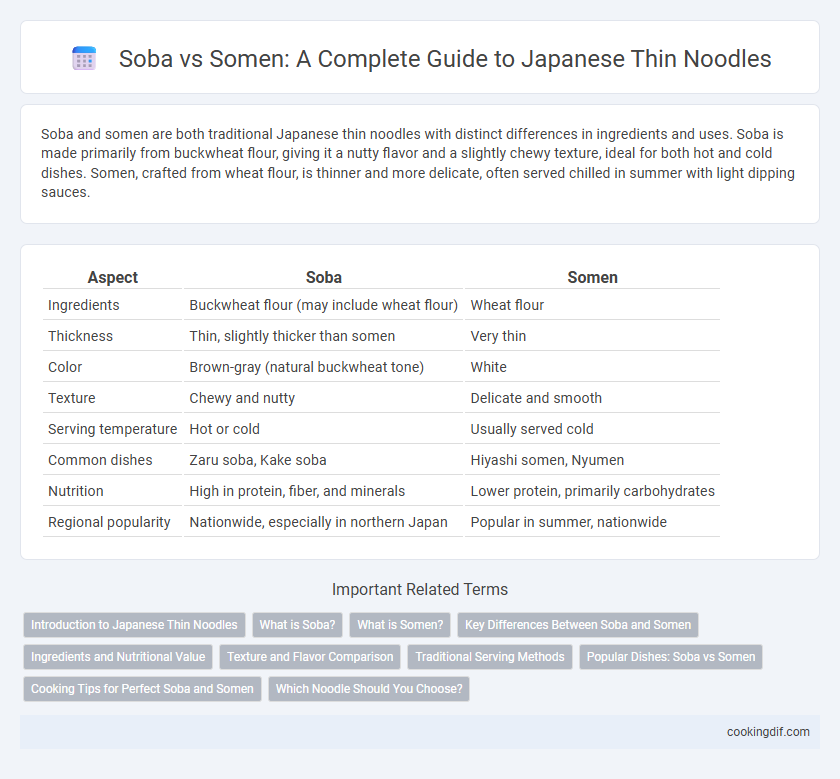Soba and somen are both traditional Japanese thin noodles with distinct differences in ingredients and uses. Soba is made primarily from buckwheat flour, giving it a nutty flavor and a slightly chewy texture, ideal for both hot and cold dishes. Somen, crafted from wheat flour, is thinner and more delicate, often served chilled in summer with light dipping sauces.
Table of Comparison
| Aspect | Soba | Somen |
|---|---|---|
| Ingredients | Buckwheat flour (may include wheat flour) | Wheat flour |
| Thickness | Thin, slightly thicker than somen | Very thin |
| Color | Brown-gray (natural buckwheat tone) | White |
| Texture | Chewy and nutty | Delicate and smooth |
| Serving temperature | Hot or cold | Usually served cold |
| Common dishes | Zaru soba, Kake soba | Hiyashi somen, Nyumen |
| Nutrition | High in protein, fiber, and minerals | Lower protein, primarily carbohydrates |
| Regional popularity | Nationwide, especially in northern Japan | Popular in summer, nationwide |
Introduction to Japanese Thin Noodles
Soba and somen are two popular types of Japanese thin noodles, each with distinct characteristics and cultural significance. Soba noodles are made from buckwheat flour, offering a nutty flavor and a slightly chewy texture, commonly served hot or cold in various traditional dishes. Somen, made from wheat flour, are thinner and smoother, often enjoyed chilled with dipping sauce during summer, highlighting the versatility of Japanese thin noodles in regional cuisine.
What is Soba?
Soba is a traditional Japanese thin noodle made primarily from buckwheat flour, known for its nutty flavor and firm texture. Unlike somen, which is made from wheat flour and has a softer consistency, soba offers a rich source of protein, fiber, and essential minerals. Commonly served cold with dipping sauce or hot in broth, soba noodles are a staple in Japanese cuisine celebrated for their versatility and nutritional benefits.
What is Somen?
Somen are ultra-thin Japanese wheat noodles measuring approximately 1.3 mm in diameter, traditionally served chilled with a light dipping sauce during summer months. Unlike soba, which is made from buckwheat flour giving it a darker color and nuttier flavor, somen's delicate texture and mild taste make it highly versatile in various cold and hot dishes. These noodles are often hand-stretched or machine-produced and are prized for their smoothness and quick cooking time.
Key Differences Between Soba and Somen
Soba noodles are made from buckwheat flour, giving them a nutty flavor and darker color, while somen noodles use wheat flour, resulting in a lighter appearance and milder taste. Soba is typically served warm or cold and has a slightly chewy texture, whereas somen is very thin, delicate, and often enjoyed chilled in summer. Nutritionally, soba contains more protein and fiber due to buckwheat content, contrasting with the primarily carbohydrate-based somen noodles.
Ingredients and Nutritional Value
Soba noodles, made primarily from buckwheat flour, offer a rich source of protein, dietary fiber, and essential minerals like manganese and magnesium, supporting heart health and digestion. In contrast, somen noodles are crafted from refined wheat flour, providing a lighter texture but lower nutritional content, with minimal fiber and protein. The buckwheat in soba contributes to a lower glycemic index compared to somen, making soba noodles a healthier choice for sustained energy and blood sugar management.
Texture and Flavor Comparison
Soba noodles boast a firm, slightly chewy texture with a nutty, earthy flavor derived from buckwheat flour, offering a rich and wholesome taste experience. In contrast, somen noodles feature a delicate, smooth texture and a mild, subtly sweet flavor, made primarily from wheat flour, making them ideal for light, refreshing dishes. Both noodles highlight distinct regional preferences in Japan, emphasizing soba's robust character versus somen's refined softness.
Traditional Serving Methods
Soba, made from buckwheat flour, is traditionally served chilled with a dipping sauce called tsuyu or in a hot broth, often garnished with nori seaweed and green onions to enhance its nutty flavor. Somen, made from wheat flour, is typically served cold during summer months with a light, chilled dipping sauce called tsuyu and accompanied by sliced ginger, shiso leaves, and sesame seeds to complement its delicate texture. Both noodles hold significant cultural importance in Japan and are enjoyed in ways that reflect seasonal customs and regional variations.
Popular Dishes: Soba vs Somen
Soba noodles, made from buckwheat, are commonly used in popular Japanese dishes like Zaru Soba, a cold noodle dish served with dipping sauce, and Kake Soba, a hot noodle soup. Somen noodles, which are thinner and made from wheat flour, feature prominently in chilled summer dishes such as Somen served with dipping sauce or in light broths. Both noodles highlight distinct textures and flavors, with soba offering a nutty taste and somen providing a delicate, smooth bite ideal for cooling meals.
Cooking Tips for Perfect Soba and Somen
For perfect soba, cook the noodles in plenty of boiling water for 4 to 5 minutes, stirring occasionally to prevent sticking, then immediately rinse under cold water to stop the cooking process and preserve the chewy texture. Somen requires a shorter cooking time, typically 2 minutes, and should be cooled rapidly in ice water to maintain its delicate softness and prevent clumping. Using fresh water for rinsing both noodles enhances flavor clarity and helps achieve the ideal al dente texture unique to each noodle type.
Which Noodle Should You Choose?
Soba and somen are both popular Japanese thin noodles, each offering distinct flavors and textures suited to different dishes. Soba, made from buckwheat, has a nutty taste and is ideal for hot soups or chilled servings with dipping sauce, providing a heartier option rich in protein and fiber. Somen, made from wheat flour, is thinner and more delicate, perfect for light, refreshing summer dishes served cold with dipping sauces, offering a mild flavor that complements subtle broths and toppings.
Soba vs somen for Japanese thin noodles Infographic

 cookingdif.com
cookingdif.com